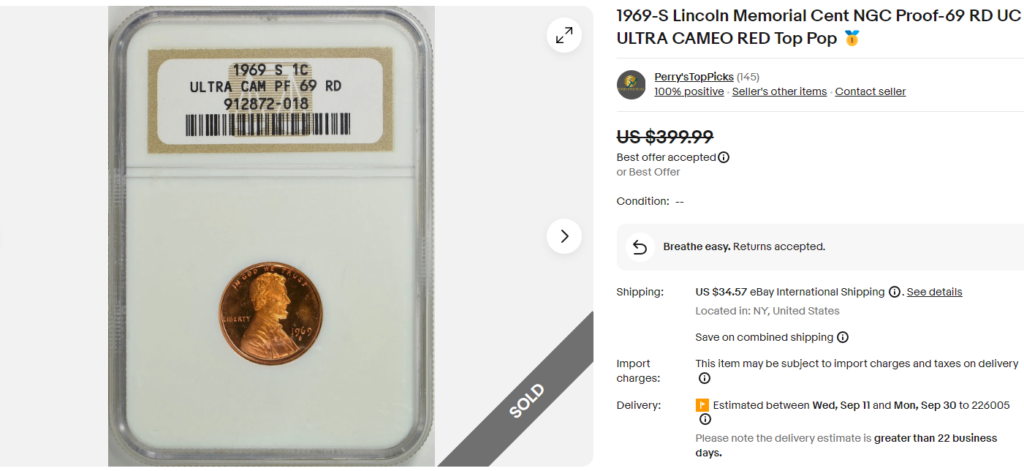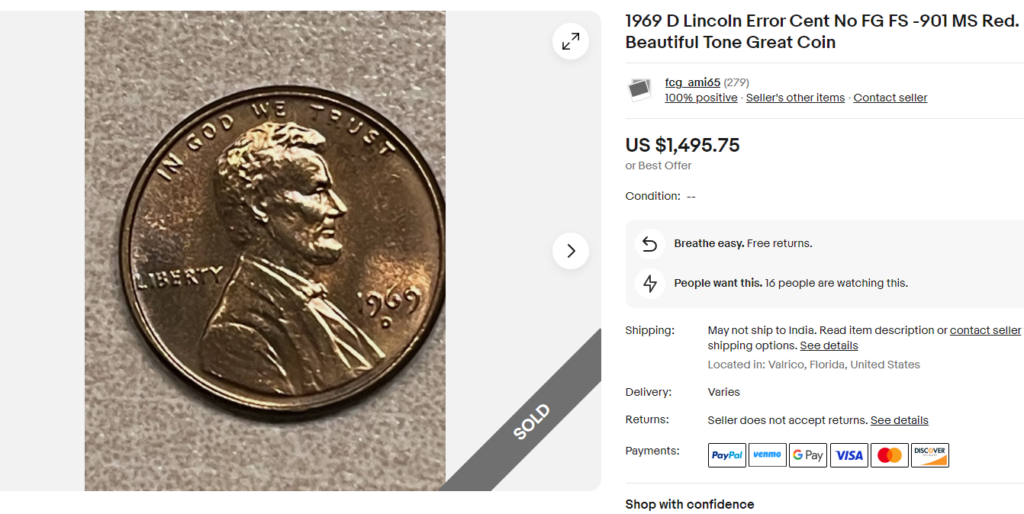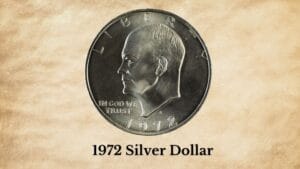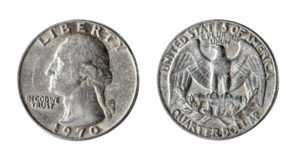The 1969 Lincoln Memorial Cent might seem like another coin jingling around in your pocket for decades, but it’s more valuable than you might think. Minted during a year that saw major events, like the moon landing, the 1969 penny can sell for as much as $50,000, in fact, even more!
But this eye-popping price is not common for all 1969 Lincoln pennies, as most are just worth a few cents. So, how would you know if your 1969 penny is valuable or not? This price guide will help you learn about all the valuable features, such as mint marks, errors, and proof strikes, that transform a regular 1969 Memorial Cent into a prized possession!
An Overview of the 1969 Lincoln Penny History
The Lincoln Penny, first introduced in 1909 to commemorate the centennial of Abraham Lincoln’s birth, had been a staple of American coinage by 1969. Designed by Victor David Brenner, the coin featured Lincoln’s profile on the obverse and the iconic wheat stalks on the reverse until 1958, when the reverse was changed to the Lincoln Memorial.

1969 was a year of significant historical events, including the Apollo 11 moon landing and the Woodstock music festival. The penny, though small, played its part in the economy of this tumultuous year. It was also a time of change for U.S. coinage, as the mint was transitioning away from silver in dimes and quarters.
The 1969 Lincoln Penny was minted in large quantities across three mints: Philadelphia, Denver, and San Francisco. Despite its common status, the penny remains a popular collector’s item, valued for its potential for rare varieties and errors!
| 1969 Lincoln Cent | Key Features & Facts |
| Material Composition | Copper-plated Zinc (97.5% Zinc & 2.5% Copper) |
| Minting Location | Philadelphia, Denver, San Fracisco |
| Minting Year | 1969 |
| Face Value | 1-cent ($0.01) |
| Weight | 3.11 grams (Copper) or 2.5 grams (Zinc) |
| Diameter | 19 mm |
| Thickness | 1.55mm |
| Designer | Victor D. Brenner (Obverse), Frank Gasparro (Reverse) |
| Mint Marks | ‘D,’ ‘S’ and No mint mark |
| Total Mintage | 5,687,051,831 |
Identifying a 1969 Lincoln Memorial Cent (Design & Composition)
Spotting a 1969 Lincoln Penny in a big lot of old coins requires observing its distinct design elements on both sides and understanding its composition and dimensions.
1969 Lincoln Penny Obverse:
- Profile of Abraham Lincoln facing right
- The inscription “IN GOD WE TRUST” above Lincoln’s head
- “LIBERTY” to the left of Lincoln’s portrait
- Date “1969” to the right of Lincoln’s chest
- Designer’s initials “VDB” (Victor David Brenner) on Lincoln’s shoulder (visible under magnification)
- The mint mark (if present) below the date
1969 Lincoln Penny Reverse:
- Lincoln Memorial building at the center
- “E PLURIBUS UNUM” across the top
- “UNITED STATES OF AMERICA” along the upper rim
- “ONE CENT” at the bottom
- Designer’s initials “FG” (Frank Gasparro) on the right side of the Memorial
Coin Composition & Physical Features:
The 1969 Lincoln Penny features a composition of 95% copper and 5% zinc and tin, known as the “bronze alloy.” This composition gives the coin its characteristic reddish-brown color (when new) and its ideal weight of 3.11 grams (0.10970 ounces).
As for the physical characteristics and size, the 1969 penny has a thickness of 1.55 mm (0.0610 inches), and its diameter is 19.05 mm (0.75 inches) with a plain (not reeded) edge. These specifications are the same for all mint locations.
5 Factors to Assess a 1969 Lincoln Penny Coin Value
The average value of a 1969 Lincoln Penny ranges from a few cents to as high as $10,000 or more, depending on several factors, such as mint mark, condition, mint errors or varieties, and others.
Now, let’s analyze how these factors really impact the 1969 penny coin’s value!
1. Coin Grading and Condition
The first and most important factor determining the worth of a 1969 Memorial Cent is its condition. Naturally, the better the coin’s condition, the more valuable it is.
Now, the coins are graded by professional services (PCGS, NGC, & ANACS) on a scale from Poor (P-1) to Perfect Mint State (MS-70), considering the wear, luster, and contact marks. Higher grades (MS-65 to MS-70) can dramatically increase your 1969 Lincoln Penny’s value.
For instance, a 1969-S penny in MS-65 Red condition might be worth $6, while the same coin in MS-67 Red could fetch over $100. Refer to this 1969 Lincoln Penny Value Chart to assess your coin’s worth based on coin grades.
| Coin Grades | 1969 1C No Mint Mark | 1969-D 1C | 1969-S 1C |
| Poor (0) to Extremely Fine (XF45) | Face value | Face value | Face value |
| Almost Uncirculated (AU50) to Mint State (MS60) | Few cents more than face value | Few cents more than face value | Few cents more than face value |
| Mint State (MS61 – MS64) | $1 – $5 | $1 – $5 | $1 – $10 |
| Mint State (MS65 – MS66+) | $5 – $45 | $5 – $200+ | $5 – $100+ |
| Mint State (MS67 – MS67+) | $200 – $1,500+ | $200 – $2,000+ | Up to $500 (MS67+ not found) |
| Mint State (MS68 or Above) | N/A | N/A | N/A |
2. Coin Toning & Coloration
This color of a 1969 Lincoln Penny also plays a crucial role in its valuation. Generally, new, mint-state pennies are reddish-brown, but over time, their colors change to brown due to oxidation. Based on this toning, Lincoln Pennies are divided into three categories:
- Red (RD): These coins retain at least 95% of their original red luster and bright orange to light red. Red pennies are the most valuable, especially in high grades.
- Red-Brown (RB): The RB-graded 1969 pennies have 5% to 94% of their red color and show a mix of red and brown tones. These pennies are less valuable than Red but more valuable than Brown.
- Brown (BN): These coins have less than 5% of their original red color and appear mostly brown, ranging from light to dark shades. BN-graded cents are worth the least among all categories.
3. Mint Marks & Mintage
The total mintage for 1969 Lincoln Pennies across all mints was an impressive 5,136,542,100 coins. The mint location is identified by the mint mark on the coin’s obverse below the mint date.
The breakdown by mint and their respective values are as follows:
- 1969 Lincoln Penny No Mint Mark: The Philadelphia Mint produced around 1,136,910,000 Lincoln cents in 1969. Being the most common 1969 pennies, they’re typically worth the face value in circulated conditions. However, in high-grade mint states (MS67), they can sell for up to $1,500.
- 1969-D Lincoln Penny: With 4,002,832,200, the Denver Mint produced the highest number of 1969 pennies. Although more common than the 1969 no-mint mark cents, the 1969-D pennies are worth the face value in circulated condition and up to $1,000 – $2,000 on high-grade mint states, such as MS67+.
- 1969-S Lincoln Penny: The San Francisco minted around 544,375,000 regular Lincoln Cents in 1969. Uncirculated MS65 RD 1969 Lincoln Pennies from this mint can be worth $6 to $8, with higher-grade examples fetching up to $1,500. Well-preserved circulated examples may fetch slightly over face value.
4. 1969-S Lincoln Cent Proof Coins
In addition to regular pennies, the San Francisco Mint also produced 2,934,631 proof of Lincoln Pennies in 1969. These coins were struck using specially polished dies and planchets, resulting in a mirror-like finish.
Proof 1969 Lincoln Pennies are worth only $2 to $5 in PR-65 condition and around $50 – $70 in higher condition, like PR-68 or above.
Some proof coins may also feature a special appearance, which increases their worth.
- Cameo Proofs (CAM): Some 1969 proof pennies feature a strong contrast between frosted devices (raised designs) and mirrored fields. These “cameo” proofs are more desirable and worth $10 to $20 in PR-65 condition.
- Deep Cameo (DCAM) Proofs: A 1969 proof coin with a more pronounced contrast between the devices and fields is graded as “Deep Cameo (DCAM)” or “Ultra Cameo.” These are the most valuable, potentially worth $30 to $50 or more in PR-65 condition, with higher examples (PR-69) fetching $300 – $900.

5. Most Valuable Errors on 1969 Lincoln Memorial Cent
Mint errors are physical anomalies that occur to a coin during minting. Below are the most valuable and rare minting errors that can significantly increase the value of a 1969 Lincoln Penny.
Double Die Obverse (DDO)
This error occurs when the die used to strike the coin is doubled during the hubbing process. To spot this error coin, look for a doubling in the lettering, especially in “LIBERTY,” “In God We Trust,” and the date.
The 1969-S DDO is one of the most valuable Lincoln cent errors, with examples selling for over $50,000 in common mint states; even MS61 examples can sell for $35,000+. One such MS64-DDO 1969 Penny sold for $58,800 on Heritage Auctions. Another MS64 example with intense doubling sold for a stunning auction record price of $126,500.
No FG Error
The 1969 Lincoln penny with the “No FG” error is a specific variety of the 1969 Lincoln Memorial cent in which the reverse side of the coin lacks the designer’s initials, “FG” (for Frank Gasparro, the reverse designer).
Most commonly found on the 1969-D penny, this error occurs because the initials didn’t get stuck into the die during the minting process. Collectors find this rare coin collectible as it is relatively scarce and can increase its value. MS-65 1969 No FG error can sell for $500, with higher-grade coins selling for $1,500 or more at a coin auction.

Repunched Mint Mark (RPM)
This happens when the mint mark is punched multiple times at slightly different angles. To spot this, examine the mint mark under magnification and look for any overlapping sides or edges. 1969 Lincoln Memorial cent RPMs can add $20-$100 to the coin’s value.
Off-Center Strikes
When a coin is struck off-center, there will be a blank crescent on the coin, and a part of the design will be missing. The value of an off-strike 1969 Lincoln penny depends on how off-center the strike is and whether the date is visible.
For example, coins that are slightly off-center (5%—$30%) might be worth $10-$20, while severely off-center (70%—80%) examples can fetch $100 or more.

6 Steps to Identify a Fake 1969 Lincoln Cent
Spotting a counterfeit 1969 Lincoln cent can be tricky, but with the right techniques, you can protect your collection from fraud. Here are the six easy steps to follow:
- Verify the Dimensions: The 1969 penny should measure 19.05 mm in diameter and 1.55 mm in thickness. If it does, it’s likely a fake.
- Check the Weight: Use a precise scale to verify the 3.11-gram weight. Any deviation hints at a counterfeit.
- Analyze the Date Font: Compare the mint date font to genuine examples from 1969. Fake coins might feature a different font.
- Examine the Mint Mark Font & Location: Ensure the mint mark (if present) matches the style used in 1969. Besides, it should be present on the coin’s obverse below the date. If a coin has the mint mark location anywhere else, it’s definitely a fake.
- Inspect the Edge: Genuine 1969 pennies have a plain edge. A 1969 penny with a reeded or modified edge is fake.
- Perform a Magnetic Test: Real 1969 pennies are not magnetic. If your coin reacts to a magnet, it’s a counterfeit.
Once you’ve ensured your 1969 Lincoln Memorial Cent is a genuine coin, you can further assess its value based on crucial factors, as explained in this guide. Whether you want to buy a 1969 penny or sell yours, it’s best to find its right price before you trade it.
Like this penny, many other Lincoln pennies are worth way more than you think. These include the 1942 penny, the 1983 penny, the 1959 penny, and the 1945 penny. If you’re interested in any of these cents, I’ve shared detailed price guides for you!
Note: This article is intended for informational, educational, and entertainment purposes only. Some images are illustrative and may not represent actual brands, products, or related entities. All trademarks, product names, brand logos, packaging, and other intellectual property referenced remain the exclusive property of their respective owners. Any brand mentions or references are provided solely for descriptive and educational context and do not imply any formal or commercial association.









